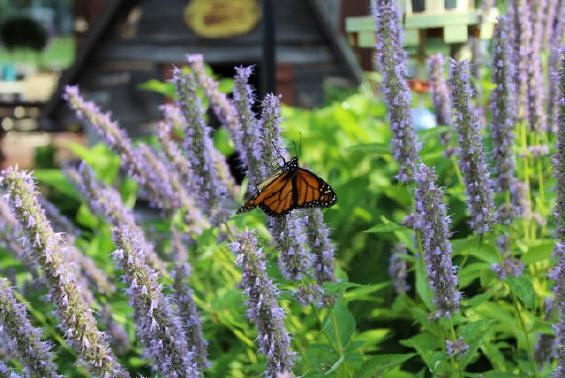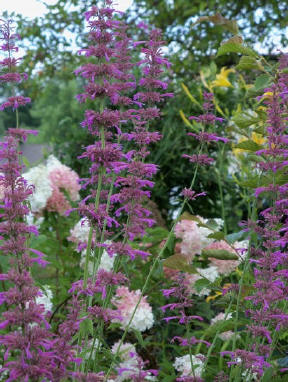Agastache, pronounced ag-ah-STAH-shee, is not only a lovely plant to grow in your garden, it is a bee, hummingbird and butterfly magnet all rolled into one. If you are interested in supporting pollinators or get excited when you see butterflies and hummingbirds in your garden, Agastache is a must-have plant. It is elegant, easy to care for and very low maintenance. It
blooms for a very long time. You can plant it in drifts along a path or scatter it through a cottage garden.
Agastache is strongly aromatic and is a member of the Lamiaceae family that also includes mints, salvia, monarda and many others. Like their cousins, Agastache likes the sun and plenty of it. The hotter, the better for them! There are 22 species of Agastache mostly all native to North America. They are commonly referred to as giant hyssops and sometimes as hummingbird
mints.

Many of the varieties are very hardy, but none of them like our heavy, clay soils, so it becomes necessary to amend the soil to accommodate them if you want them to survive for a number of years. They absolutely cannot abide standing water or wet soil. Try planting them on a sunny, south or west facing slope or in a raised bed with sandy, fast-draining soil. You might
try planting them high and then mulching with some crushed gravel that will absorb heat on a sunny day and encourage better drainage. A master gardener friend told me the secret is to actually position the crown on a large stone when planting.
Agastache forniculum, also called anise hyssop and sometimes referred to as Giant Blue Hyssop, is the most likely to survive winters in our area. Depending on the variety you choose, it can grow as tall as six feet in height. Its blue candle-shaped flowers bloom at the top of the plant and are easily spied by visiting butterflies and hummingbirds. The leaves have a
strong licorice scent which, hopefully, makes it undesirable to deer and rabbits.
Agastache ‘Golden Jubilee’ is a popular variety which produces bright golden foliage with blue candles. This plant grows only about two to three feet tall and easily reseeds itself.
Agastache hybrids often have showier flowers and better winter hardiness than the species plant. A popular hybrid, ‘Blue Fortune’, which produces powder blue spikes over deep green foliage, is also considered one of the best to withstand our heavy, wet soils. It stands about three feet tall and begins to bloom in midsummer just when butterflies are most plentiful.
 I have grown Agastache ‘Purple Haze’, a beautiful hybrid. 'Purple Haze’, as the name suggests, creates an impressive mass of bluish-purple flowers that bloom for a very long time in summer. Periodically deadheading spent flowers will help to prolong bloom and prevent the plant from setting seed. Leaving the
leaf and flower stems intact through the winter helps protect the crown from extreme cold. Cut them off about five inches above the ground sometime in March.
I have grown Agastache ‘Purple Haze’, a beautiful hybrid. 'Purple Haze’, as the name suggests, creates an impressive mass of bluish-purple flowers that bloom for a very long time in summer. Periodically deadheading spent flowers will help to prolong bloom and prevent the plant from setting seed. Leaving the
leaf and flower stems intact through the winter helps protect the crown from extreme cold. Cut them off about five inches above the ground sometime in March.
Agastache species can easily be grown from seed, but hybrid varieties will cross pollinate and produce specimens that are not at all like the parent plant. Hybridized varieties should be propagated from softwood cuttings.
My personal all-time favorite Agastache is ‘Tutti Frutti’, (Agastache mexicana x barberi) which is a species native to the southwest U.S and Mexico. When it is in a happy place, its flowers form a huge, airy, eye-catching array of raspberry pink. It blooms non-stop from early summer until frost. I have never been able to get it to come back even though it is rated for
zone 6. This year, I took the advice of my friend and planted it on a small rock. I am hopeful. The plants are inexpensive and grow quite fast, so treating them as annuals is not a terrible thing. However, they are sometimes difficult to find. Since this variety is not a hybrid, you can try saving the seed.
Don’t confuse Anise Hyssop (Agastache forniculum) with the Hyssop (Hyssopus officinalis) mentioned several times in the Bible. Although they are very similar, you can see by their botanical names that they are actually completely different plants. This is one more lesson in the importance of botanical names over relying on common names.
Anise Hyssop (Agastache) is very edible. You can use the leaves and flowers, either fresh or dried, to make teas. (Make sure they have not been exposed to a pesticide.) Their minty flavor makes them go well with berries and peaches. The tea is often used as a common cold remedy. It is sometimes taken to strengthen the heart, and clinical research has shown that its
oils act as an antiviral against Herpes Simplex I and II.
When you are plant shopping this spring, keep your eye out for a small 4" X 4" pot of Agastache ‘Tutti Frutti’. Plant it in a sunny, well-drained spot in the ground, or in a pot. When friends walk into your garden and exclaim, ‘Wow! What is that beautiful plant?" You will thank me all summer.
Read other articles on garden and landscape design